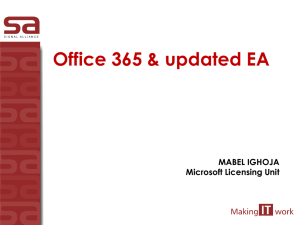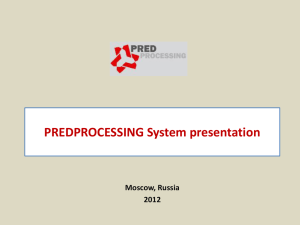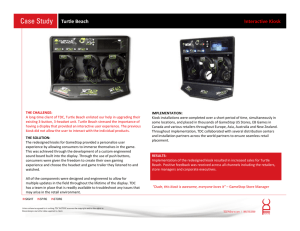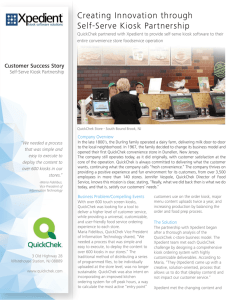Agent Model on Information Kiosk Systems Supporting Mobile Users Yasuhiko Miyazaki
advertisement
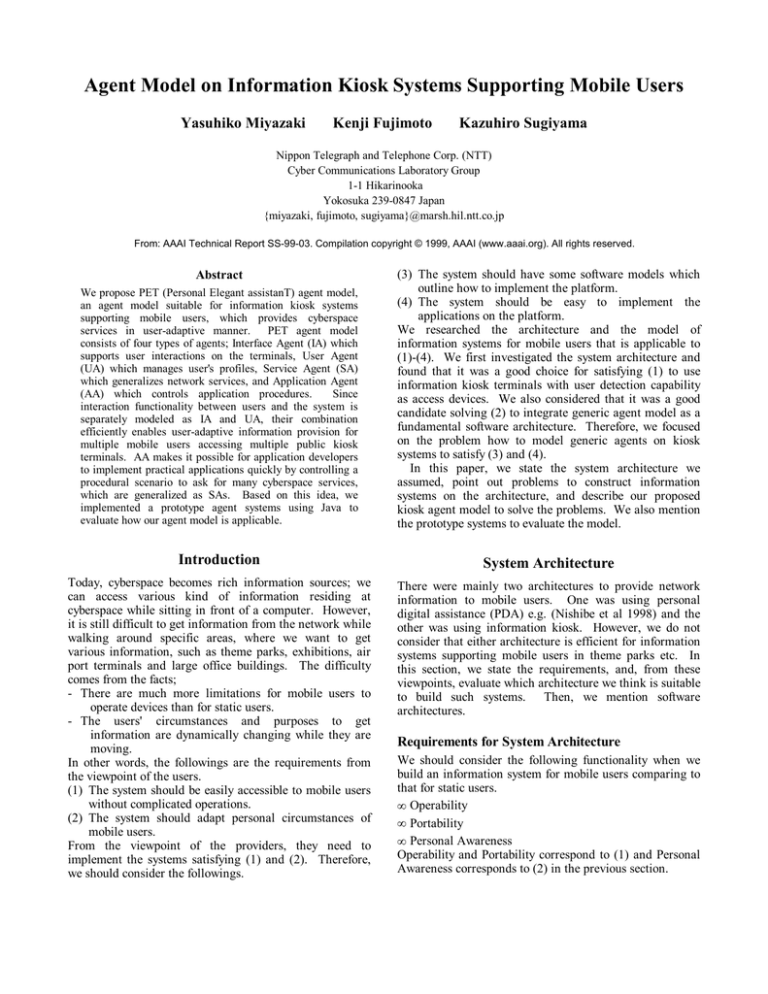
Agent Model on Information Kiosk Systems Supporting Mobile Users
Yasuhiko Miyazaki
Kenji Fujimoto
Kazuhiro Sugiyama
Nippon Telegraph and Telephone Corp. (NTT)
Cyber Communications Laboratory Group
1-1 Hikarinooka
Yokosuka 239-0847 Japan
{miyazaki, fujimoto, sugiyama}@marsh.hil.ntt.co.jp
From: AAAI Technical Report SS-99-03. Compilation copyright © 1999, AAAI (www.aaai.org). All rights reserved.
We propose PET (Personal Elegant assistanT) agent model,
an agent model suitable for information kiosk systems
supporting mobile users, which provides cyberspace
services in user-adaptive manner.
PET agent model
consists of four types of agents; Interface Agent (IA) which
supports user interactions on the terminals, User Agent
(UA) which manages user's profiles, Service Agent (SA)
which generalizes network services, and Application Agent
(AA) which controls application procedures.
Since
interaction functionality between users and the system is
separately modeled as IA and UA, their combination
efficiently enables user-adaptive information provision for
multiple mobile users accessing multiple public kiosk
terminals. AA makes it possible for application developers
to implement practical applications quickly by controlling a
procedural scenario to ask for many cyberspace services,
which are generalized as SAs. Based on this idea, we
implemented a prototype agent systems using Java to
evaluate how our agent model is applicable.
(3) The system should have some software models which
outline how to implement the platform.
(4) The system should be easy to implement the
applications on the platform.
We researched the architecture and the model of
information systems for mobile users that is applicable to
(1)-(4). We first investigated the system architecture and
found that it was a good choice for satisfying (1) to use
information kiosk terminals with user detection capability
as access devices. We also considered that it was a good
candidate solving (2) to integrate generic agent model as a
fundamental software architecture. Therefore, we focused
on the problem how to model generic agents on kiosk
systems to satisfy (3) and (4).
In this paper, we state the system architecture we
assumed, point out problems to construct information
systems on the architecture, and describe our proposed
kiosk agent model to solve the problems. We also mention
the prototype systems to evaluate the model.
Introduction
System Architecture
Today, cyberspace becomes rich information sources; we
can access various kind of information residing at
cyberspace while sitting in front of a computer. However,
it is still difficult to get information from the network while
walking around specific areas, where we want to get
various information, such as theme parks, exhibitions, air
port terminals and large office buildings. The difficulty
comes from the facts;
- There are much more limitations for mobile users to
operate devices than for static users.
- The users' circumstances and purposes to get
information are dynamically changing while they are
moving.
In other words, the followings are the requirements from
the viewpoint of the users.
(1) The system should be easily accessible to mobile users
without complicated operations.
(2) The system should adapt personal circumstances of
mobile users.
From the viewpoint of the providers, they need to
implement the systems satisfying (1) and (2). Therefore,
we should consider the followings.
There were mainly two architectures to provide network
information to mobile users. One was using personal
digital assistance (PDA) e.g. (Nishibe et al 1998) and the
other was using information kiosk. However, we do not
consider that either architecture is efficient for information
systems supporting mobile users in theme parks etc. In
this section, we state the requirements, and, from these
viewpoints, evaluate which architecture we think is suitable
to build such systems. Then, we mention software
architectures.
Abstract
Requirements for System Architecture
We should consider the following functionality when we
build an information system for mobile users comparing to
that for static users.
• Operability
• Portability
• Personal Awareness
Operability and Portability correspond to (1) and Personal
Awareness corresponds to (2) in the previous section.
User’s
Profile
Interaction PC/PDA
Information
Server
Information
Server
Network
DF-ID
Antenna
Camera
DF-ID card
Display
Touch Panel
Speaker
Figure 1 System Architecture
Architecture PDA
Kiosk terminal
Kiosk terminal with
user detection function
Evaluation
palmtop size
wrist watch size
Operability
OK
Hard to operate.
Hard to see pictures
and maps.
OK
OK
Portability
Annoying to hold it
anytime anywhere.
OK
OK
OK
Personal
Awareness
OK, Configurable for
the user.
OK, Configurable for
the user.
Public use.
OK, Possible to
integrate with personal
profile.
Table 1 Comparisons of system architectures
Operability means how easily users can access to the
network information without complex user operations.
Operations available outside are usually very restricted.
They cannot use sensitive pointer devices or keyboards, for
example.
Portability means how easily users can carry equipment
necessary to access information. Mobile users, especially
walking users, do not want to bring disturbing devices only
for information systems.
Personal awareness means how much the system can
consider each user's needs. The destinations and purposes
of mobile users are usually different from those of others.
In addition, appropriate interactions are depending on the
environments. For example, audio output should be louder
in noisy place while it should be avoided in quit library.
Furthermore, as the users move, such needs and
environments are dynamically changing. The architecture
has to be aware of each user's circumstances.
Comparison of Hardware Architectures
Table 1 shows comparisons for information system
architectures. PDA cannot solve the trade-off as for
operability and portability. Existing kiosk terminals ca
nnot support personal awareness, either.
The solution we thought of is using information kiosk
terminals with user identification function, which can
detect and identify the person in front of them (see the
right most column in Table 1). It is feasible by using
generic agents
Agent
Agent
Agent
Agent Platform
AMS
register agents
ACC
message transfer
DF
yellow page
service
ACL (Agent Communication Language)
messages
OS / Java VM / CORBA etc.
Figure 2 FIPA Agent Reference Model
recent face recognition technology, for example. More
practical solution is using RF-ID (Radio Frequency
Identification) technology. Users bring a tiny RF-ID tag in
their pockets, which terminals detect and identify the user.
Hence, we adopted the system architecture shown in
Figure 1. The system consists of information servers, user
profile servers and interaction terminals which can identify
users.
Communication Channel router (ACC). An agent resides
in an Agent Platform (AP) by registering into Agent
Management System (AMS). Directory Facilitator (DF)
provides yellow page service; it tells which agent has what
services. We found that this model was applicable to our
target systems.
Problem Description
Generic Agent Architecture
We considered an agent model as a software architecture
which enables the personal awareness.
Recently, a lot of agent researches have been going on as
Bradshaw reviewed in his book (Bradshaw 1997). Gilbert
(Gilbert et al 1995) described agents by three dimensions,
agency (= degree of autonomy), intelligence, and mobility.
Three primitive attributes of agents in (Nwana 1996) are
autonomy, cooperation, and learning. Shoham (Shoham
1997) stated that many researchers defined "agent" as an
entity that functions continuously and autonomously. We
paid attention to this autonomy to build user adaptive
information systems for mobile users, for autonomous
agents carry out their actions in response to users'
environments. Agents would adjust audio volume in
response to the environment, for example.
Some work forces to standardize agent technologies have
been emerged, such as FIPA and OMG. Figure 2 shows
the FIPA agent reference model described in (FIPA 1997),
which was widely discussed and accepted. It defined that
an agent is the fundamental actor that has service
capabilities and interacts with each other by
communicating with conceptual message written in Agent
Communication Language (ACL) through Agent
In order to build real kiosk information systems, we have to
implement personal-aware software systems on an agent
model. This implies that we should define a particular
agent model based on the generic agent architecture like
FIPA model. In this section, we discuss what is necessary
for the agent model on kiosk information systems.
Our model must satisfy (3) and (4) described before. As
for (3), the specific problem of kiosk information systems
is the user interactions (i.e. functionality for
communication between the user and the system such as
input and output) for mobile users in applicationindependent. Therefore, we focused on the following two
problems to define kiosk agent model, which have not been
well addressed before.
• [Problem 1] How to support user-adaptive interactions
on multiple and shared terminals, which is derived
from (3).
• [Problem 2] How easily to define practical applications,
which corresponds to (4).
We discuss the detailed issues of the problems below.
Personalization of Public Kiosk Terminals
[Problem 1]
“Tell me the way to
the gate of my flight”
Start
Ask the user
the flight number
search the flight information
server to get the gate number
Is the gate assigned?
access to airport information
server to get guidance
tell that the gate has not
been determined
show the guidance
end
Figure 3 Procedural User Request
As is stated in the previous section, we concluded that in a
viewpoint of user operations, kiosk terminals are better
than personal devices for walking users. However, we
should consider how to realize personal awareness by
combination of user identification functionality of the kiosk
terminals and user preference servers on the network. It is
not trivial because the relationship between mobile users
and public kiosk terminals is m-to-n; a user accesses many
terminals and a terminal is used by many users. We have
to take the following issues into consideration.
- [P1-1] Since a kiosk terminal is in public use, the
appearances and operations should be configured
dynamically according to the user's preferences.
- [P1-2] As the devices of the terminals are not exactly
same each other, the system should encapsulate the
deference of their capability.
- [P1-3] A terminal may simultaneously find several users
in front of it but can interact with only one of them due
to device limitations. A mechanism would be useful to
let the other users know who has a message from the
system.
- [P1-4] Several information sources may try to access the
users via public terminals at the same time. On the
other hand, a terminal needs to serialize them if it
presents them by synthesized voice, for example.
Therefore, it is important to control conversation
threads to the users. Otherwise, the users are confused
to whom and in which context the system tells the
information.
Application Development of Agent-based Systems
[Problem 2]
We found that many user requests for information systems
were procedural. In the airport, for example, the request
"Tell me the way to the gate of my flight." can be defined
as a flow chart shown in Figure 3. Therefore, applications
of the kiosk information systems are often described as
scenarios.
On the other hand, most multi-agent
architectures discussed in AI (Artificial Intelligence) area
have each agent to make its own planning to achieve a
given goal or sub-goal. This approach makes it difficult to
foresee the total scenario done by many involved agents.
We believe that directly defining application scenarios is as
important as multi-agent planning. Hence, the following
points are necessary for practical agent applications to
emerge.
- [P2-1] Agent architecture should allow application
developers to define total scenarios.
- [P2-2] The architecture should still have flexibility to
varieties of environments with agents' autonomy.
Proposal of Kiosk Agent Model
Our first approach toward Problem 1 was modeling the
terminal and the users' profile as separate types of agents
called IA and UA. Then, we can realize the user-adaptive
information systems by the combination of a public kiosk
terminal (IA) and a profile (UA) of the user who is
identified by the terminal. We thought that sub-problems
[P1-1]-[P1-4] could be solved by defining mandatory
functions that each type of agent should provide.
Similarly, our approach toward Problem 2 was modeling
total application scenario controller as an agent called AA.
Also we modeled various service providing agents called
Service
Provision
User Interaction
Detection
User Preference
Management
SA
IA
WWW,
mail etc
UA
AA
profile
Scenario
Control
IA
UA
SA
AA
profile
IA
Sensor
SA
DB
Figure 4 PET Agent Model
IA
devices
[P1-1] Personal Awareness
on public terminals
waiting list management
conversation management
[P1-2] Deferent functionality
[P1-3] Background User
[P1-4] Conversation
concurrency control
fundamental set of action I/F
UA
user’s profile
conversation management
application scenario control
[P2-1] Procedural applications
search appropriate services
[P2-2] System flexibility
conceptual services
service registration
AA
FIPA DF
Yellow
Page
SA
Figure 5 Approaches based on PET Model
SA. We thought that defining AA was a solution to [P2-1]
while SA kept flexibility pointed out in [P2-2].
From these considerations, we proposed an agent model
called PET (Personal Elegant assistanT) model, which
consists of four types of agents. (Figure 4)
- Interface Agent (IA)
- User Agent (UA)
- Service Agent (SA)
- Application Agent (AA)
Figure 5 illustrates our approaches toward the above
problems with the PET model. We consider that this
approach is the most appropriate because it is simple and
enough to give solutions to the problems.
In the following subsections, we describe detailed
functionality which each agent type should support in order
to solve them.
Character for background user who is in waiting list
This is the
information
about NTT
Character for foreground user
Figure 6 Foreground and Background Characters
Action
Description
conversation-setup
begin the conversation.
conversation-terminate
complete the conversation.
conversation-control
put the conversation in waiting queue since the IA cannot directly
interact the user currently.
present
output the information to the user.
listen
input the information from the user.
select
ask the user a selective questions and get the answer.
Table 2 Actions of IA
Interface Agent (IA)
IA is an agent of a terminal which deals with user
interactions directly.
IA should have interaction and detection capabilities
corresponding to kiosk terminals we assumed. The
interaction can be done according to devices installed in
the terminal, for example, by GUI, speech synthesis and
recognition, animation display, and/or gesture recognition.
The detection, by which IA can detect and identify the user,
can be realized by RF-ID, face recognition, voice
recognition, and/or user's login operation.
This
functionality may allow users to access information by only
approaching the terminal.
Followings are detailed actions which IA should support
to solve [P1-1]-[P1-4].
[P1-1] IA gets preferences of the interacting user from
his/her UA and executes configuration. The configuration
is done autonomously according to the modality the IA
supports. For example, IA which interacts by animation
gets the character the user likes; IA which is able to
present multilingual information gets the user's native
language. The user's favorite configuration is useful
especially for animation display. Since the same character
appears wherever the user approaches, it seems that the
personal secretary accompanies with him/her.
[P1-2] To encapsulate IA's functionality, we defined
fundamental actions shown in Table 2 which every IA
should support.
Each IA performs these actions
autonomously depending on its capability. Similar actions
were also approved in [FIPA 1998] Part 12, Human-Agent
Interaction specification.
[P1-3] Although IA finds several users to whom the
system wants to tell information, the IA may not interact
with all of them simultaneously because its audio device is
exclusive or display area is not wide enough to open
multiple windows. Even if the IA does not fully interact
with multiple users, however, it may inform those who are
not on the interaction (called background users) that they
have messages from the system by showing their small
characters (Figure 6), for example. To model this
functionality, we defined conversation-control action to
control user interactions in the waiting list. When the
foreground user leaves, one of the background users in the
list is chosen and promoted to the foreground user, then the
IA starts full interactions with him/her.
[P1-4] IA needs to control interactions for multiple users
by switching the conversations in case it is requested by
multiple UAs at the same time. Conversation-setup and
conversation-terminate actions, with conversation-id
parameter in each action message, are used for concurrency
control of user interactions. Although control policy is
determined autonomously by each IA, we believe that IA
should switch the conversation as little as possible to avoid
users' confusions, which is different from the DBMS policy
where high concurrency is desirable.
User Agent (UA)
UA behaves on behalf of the user, by being always on the
network to interact with other agents. UA plays an
important role for [P1-1] and [P1-4].
[P1-1] UA manages user's preference data for IA to
personalize the interactions like animation character data
and his/her native language.
In addition, UA has
preference data such as his/her name, address, email,
hobby, interest etc. to personalize information provision in
two ways. First, as UA gives the user's preference data to
provider agents on his/her behalf1, they can provide more
appropriate information. Second, as messages to the user
are sent via UA, it can filter or prioritize them according to
the user's preference. In case of transportation guidance
application, for example, UA sorts several candidates by
fees if the user cares the cost, or it filters out the ways to
walk more than the given threshold if the user is unwilling
to walk long distance. Therefore, the system can provide
user-adaptive information; the user can access what he/she
wants in the way he/she likes.
[P1-4] On behalf of a user, UA receives messages from
several agents having information for him/her while the
user is out of terminals as well as he/she is interacting.
Therefore, UA has to manage the messages to keep the
conversation threads.
Like the messages to IA,
1
The user's authorization mechanism should be involved
for real systems.
Conversation-id to UA is also used to indicate the thread.
Although UA could merge several conversation threads
concurrently, we believe that, when a certain IA detects
the user and notifies the UA, it should send the interaction
messages to the IA sequentially to avoid his/her confusion.
Service Agent (SA)
SA provides services to other agents in the system by the
form of agent messages. Typical examples are the Internet
services (e.g. WWW and email), personal schedule service,
databases (e.g. flight reservation, employee and map), and
environmental sensors (e.g. to see traffic congestion, length
of queues or door lock status).
In the FIPA agent reference model, SA can be defined as
a generic agent providing service. In order to solve [P2-1]
and [P2-2], the followings are points.
- [P2-1] SA provides services in the conceptual level as
Agent Communication Language (ACL) messages.
- [P2-2] SA registers its service contents to Directory
Facilitator (DF) so that other agents can dynamically
find appropriate SA by asking DF.
Application Agent (AA)
AA controls an service scenario by combining several SAs
providing simple services to satisfy user's relatively
complex request.
[P2-1] Upon user's request or another event trigger, AA
is invoked.
It controls the application scenario by
requesting appropriate SAs to get services or information
and by interacting with the user through his/her UA. AA
is a quite procedural agent; the framework of its behavior
is predetermined. We believe that the procedural approach
to applications of information systems is necessary because
users expect the system to perform the procedure they
expect. From practical point of view, it is easier to
implement a procedural application as a single agent, AA
than to make each agent have a scenario of the procedure
separately.
[P2-2] Although AA has a predetermined scenario, it
can still keep autonomy and flexibility as an agent; AA
dynamically chooses appropriate instances of SA by
searching DF so that it can avoid congested or stopped SA.
Also, AA can provide user-adaptive information by
interacting with the user through the mechanism of UA
and IA described above.
Prototype Systems
We implemented an agent platform for PET model using
Java. Then, we realized several applications to evaluate
the model.
PET Agent Platform
We defined most agents as Java Object which has its own
Thread. Basic Agent class has common methods such as
receiving and sending messages, registering to the platform,
IA Kiosk terminal based on
browser
Kiosk terminal based on
animation
Telephone
Action
conversation-setup
open a conversation page
animation character (avatar)
shows up
make a phone call
present
display on the browser
avatar speaks and displays in
a balloon
speak
select
display radio buttons using
HTML forms and accept
inputs
avatar speaks prompts and
shows buttons on the touch
panel screen and/or set up
voice recognition engine
with the candidates
speak prompts and receive
touch tone
listen
display input field using
HTML forms and accept
input
record voice and/or accept
keyboard input
record voice and/or receive
facsimile
conversation-terminate
back to home page
avatar disappears
hang up
Table 3 Sample implementations of IA actions
and monitoring. IA, UA, SA and AA classes are defined
by extending the Agent class. Actual services and
application scenarios are hierarchically defined in the
subclasses of SA and AA. So are the functions of IA and
UA.
Some other agents are implemented by C++ since they
need to link C++ libraries such as voice recognition engine
and CTI (Computer Telephony Integration) engine.
Messages are based on XML (W3C)and sent via TCP/IP
socket to agents on the remote hosts and directly via
message queue to those on the local host.
Implementation of Agents
Here, we state some ideas to realize functions of each type
of PET agent described in previous section.
IA
We implemented three types of IAs. Browser-based IA is
for low performance terminals, Animation-based IA is for
high performance terminals, and Telephone IA is for
calling mobile phones. The executions for the requested
actions are shown in Table 3.
UA
UA needs to have a conversation queue to keep messages
from multiple AAs and send them to an IA sequentially in
order to avoid too much conversation switching for the user.
After receiving the reply from IA and forwarding it to the
requesting AA, UA should not process another AA's
request immediately. Therefore, we have the UA wait for a
few seconds to see if the first AA sends the next request
continuously.
AA
For rapid application development, scripting is very useful.
We implemented Interpreter AA which interprets XMLbased scripts. Since the scripts can directly embed XMLbased agent messages, the Interpreter AA enables us to
program the contents of the agent messages and control
their sequences easily.
Museum Guide Application System
We implemented a prototype application of PET agent
system for museum guide.
IA2
Exhibition
Hall 2
IA1
Exhibition
Hall 1
IA3
Exhibition
Hall 3
Registration IA
UA, AA SA
Agent Platform Server
Phone
IA
Entrance
Figure 7 Museum Guide Application Architecture
We assume that guests of the art museum are provided
RF-ID tag at the entrance, then, if it is the first time, they
register their names, mobile phone number, favorite
animation characters (avatars) and their interested events
(e.g. special movie, demonstration, tour, etc.). There are
kiosk terminals with RF-ID antenna at the corner of
exhibition rooms. Each kiosk terminal has IA which is
connected to the PET agent platform server where UAs,
AAs and SAs are running. We install Telephone IA which
can call the user's mobile phone to inform him/her of
emergency messages. (See Figure 7)
Application Scenario 1 - Guidance
We implemented the art guidance application:
"When the user, say Mary, enters Exhibition Hall 1, her
avatar automatically shows up and explains pictures and/or
sculptures in the hall according to her interests."
This scenario is executed by the following agents'
interactions.
1. IA 1 detects Mary by RF-ID antenna.
2. IA 1 sends user-login to her UA.
3. UA starts Interpreter AA with the script for Hall 1 as a
default.
4. AA requests UA to start conversation with her.
5. Since UA knows that the user is coming in front of IA 1,
UA sends conversation-setup to IA 1.
6. IA 1 has her avatar show up.
7. AA gets her interests from UA
8. According to the interests, AA gathers necessary
information from SAs and makes a guidance scenario.
9. AA requests UA to play it
10. UA sends present (and select if necessary) to IA 1.
11. The avatar on IA 1 explains the work of art.
12. UA sends select to ask if she wants other
presentations.
13. If she chooses another presentation, UA starts the
corresponding Interpreter AA, then repeat 7-12.
14. If she wants no more, UA sends conversationterminate.
15. IA 1 has the avatar disappear.
Application Scenario 2 - Messaging
In addition to the guidance application, we implemented
the messaging application:
"When the other user, say Tom, needs to contact Mary in
the museum, he sends a message to her via PET agent
system, which tells her by the appropriate way."
Here, "appropriate way" means that
- if Mary is at a terminal, it interrupts the guidance and
tells the message. (case 1)
- if Mary is not at a terminal, the system holds the
message and tells it when any IA finds her. (case 2)
- if Mary has a mobile phone and the message is
important, the system calls her and tells it. (case 3)
The agents' interactions in this scenario is as follows.
1. Like 1-3 in scenario 1, Tom connects his UA through IA
and starts the messaging AA.
2. AA get UA's list which it can contact with.
3. AA asks Tom's UA to whom (which UA) to send the
message.
4. His UA sends select to IA to choose to whom he wants
to tell.
5. AA gets the reply, Mary.
6. AA asks his UA the message to Mary.
7. His UA sends listen to IA to input the message.
8. AA sends the message to Mary's UA.
9. Since her UA knows the situation (case 1-31), it sends
present to
(in case 1) currently interacting IA
(in case 2) some IA which sends user-login to her UA
when it finds her.
(in case 3) telephone IA
10. Similarly, AA can get a reply from Mary by sending
listen via Mary's UA and tell it to Tom by sending
present via Tom's UA.
Discussions
By implementing not only applications to retrieve
information but also those to assist user communications,
we confirmed that our PET model is well applicable to the
museum guide system, which is our typical target, from the
following considerations.
For the application developers, they do not need to
program how to interact with mobile users using various
terminals since UA autonomously does. In Scenario 2, the
messaging AA does not care the cases 1-3. They have only
to program what to interact in the form of XML. This
feature is very useful in the real museum guidance because
they have to make explanations for a lot of exhibitions.
For the users, the animation and detection functions of
high performance IA are impressive since they can access
not only guidance but also messages from other persons
with a few voice operations. However, other types of IAs
are also important because they are not to restricted in
moving around.
Conclusion
We researched the user-adaptive information systems for
mobile users in theme parks etc. where they want to access
cyberspace services. Mobile users expect the system to be
aware of each user's circumstances and easy to operate
without carrying any devices that disturb to walk around.
Considering these user requirements, we adopted the
system architecture which consists of information kiosk
terminals with user detection function and generic agent
model.
We had to construct an agent model for kiosk
information systems to support mobile users' interactions
and to enable procedural application development easily.
Our proposed model, PET model consists of four types of
agents;
- IA, which supports efficient operability for the mobile
users by encapsulating functionality of kiosk terminals.
- UA, which manages the user's profile to personalize the
system.
1
In our current implementation, UA determines the
importance of the message only by <priority> tag in XML.
If we make more intelligent UA, it can determine totally by
the sender, the contents, the user's location, etc.
- SA, which provides services by conceptual agent
messages.
- AA, which controls the scenario to enable practical
applications.
The combination of IA and UA enables efficient mobile
user's interactions on publicly shared kiosk terminals,
which are in m-to-n relationship. AA allows application
developers to define procedural application scenario as a
single agent which utilizes generalized cyberspace services,
SAs.
By implementing a Java based prototype system, we
found that the model was efficiently applicable to the useradaptive information systems for mobile users.
As future woks, we plan to implement more IA's using
various interaction methods, integrate with more
intelligent technologies, realize privacy management, and
evaluate more aspects of agent systems.
References
Bradshaw, J. 1997. "An Introduction to Software Agents",
Software Agents, AAAI Press
FIPA (Foundation for Intelligent Physical Agents) 1997.
"FIPA 97 Specification" Part 1-3, http://www.cselt.it/fipa/
spec/fipa97/fipa97.htm
FIPA (Foundation for Intelligent Physical Agents) 1998.
"FIPA 98 Specification", http://www.fipa.org/spec/
fipa98.html,
Gilbert, D.; Aparicio, M.; Atlinson, B.; Brady, S.;
Ciccarino, J.; Grosof, B.; O'Connor, P.; Osisek, D.; Pritko,
S.; Spagna, R.; and Wilson, L. 1995. "IBM Intelligent
Agent Strategy", IBM Corp
Nishibe, Y.; Morihira, I.; Hattori, F.; Nishimura, T.;
Yamaki, H.; Ishida, T.; Maeda, H.; and Nishida, T. 1998.
"Mobile Digital Assistants for International Conferences",
Community Computing, pp. 245-284, ed. by Toru Ishida,
Wiley
Nwana, H. S. 1996. "Software Agent: An Overview",
Knowledge Engineering Review, 11(3) pp.205-244
OMG (Object Management Group)
http://www.omg.org
Shoham, Y. 1997. "An Overview of Agent-Oriened
Programming", Software Agents, pp.271 ed. by Jeffrey
Bradshaw AAAI Press
W3C (World Wide Web Consortium) "Extensible Markup
Language ", http://www.w3.org/XML
